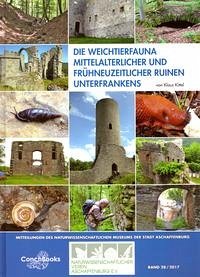Mollusc communities at 88 mainly medieval sites of ruined castles, churches, and chapels in Lower Franconia were studied. Depending on the conditions prevailing on the different sites, the data were recorded for the mesostructures regarded as suitable habitats for molluscs (walls, open copings, moats) and separately for the castle mounts. In addition each ruin is described in a short historical treatise, together with a view to its actual remains and the human influence to the local mollusc community. The distribution and current stock in Lower Franconia are described for some selected species whose presence at the ruin sites appears to be important for faunistic, ecological or historical reasons.Im Bereich von insgesamt 88, meist mittelalterlichern Ruinen von Burgen, Schlössern, Kirchen und Kapellen sowie Burgställen in Unterfranken wurde die Weichtierfauna untersucht. Abhängig von den vorgefundenen lokalen Gegebenheiten erfolgte eine getrennte Erfassung im Umfeld der als Weichtier-Lebensräume besonders geeigneten Kleinstrukturen (Mauern, unversiegelte Mauerkronen, Burggräben) und der Burgberge. Zusätzlich zu jeder einzelnen Ruine wird ein kurzer historischer Abriss, ein Blick auf den aktuellen baulichen Zustand und eine Einschätzumg des menschlichen Einflusses auf die hier lebende Weichtier-Gemeinschaft gegeben. Für einige ausgewählte Arten, deren Vorkommen im Bereich der untersuchten Ruinen faunistisch, ökologisch oder kulturhistorisch bedeutsam sind, wird die Verbreitung und Bestandssituation in Unterfranken dargestellt.

